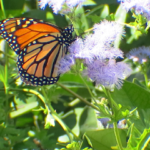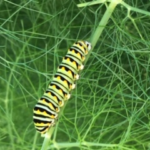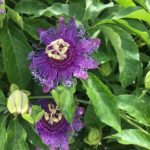Select Butterfly Plants for Adults and Caterpillars

Natives like Gregg’s Mistflower are a great butterfly plant
Nectar and larval (caterpillar) food are both important considerations to selecting butterfly plants for your garden. Luckily, many plants, like fennel and dill, are utilized for the entire life cycle of a butterfly. Trees and shrubs also play a role in the butterfly life cycle, and are often overlooked in the butterfly garden. Native butterflies often seek out specific native plants to lay their eggs. A great resource on this is available from the AgriLife bookstore: Native Host Plants for Texas Butterflies.
Plants for Extended Season
Adult butterflies are attracted to many flowering plants as nectar sources, and aren’t particular whether it be native or not. The most important consideration is to create a landscape that has a succession of flowering plants that provide nectar all season. Herbs, annual flowers, and even bolting plants in the vegetable garden can all be nectar sources. Weeds can play a part too if you need an excuse not to be a tidy gardener.

Fennel is a food source for both the adult swallowtail butterfly and its caterpillar.
While we always encourage you to landscape with native and adapted plants, having areas of annual flowers that attract pollinators can bring extra enjoyment to your gardening endeavors. With the right plants, small gardens on balconies, roof tops, or patios can also be utilized to attract butterflies. For these gardens, the only limiting factors are sun and whether they are too far away from the vertical flight path.
To help you decide what to plant in your garden, Travis County Master Gardener Daphne Jeffers has developed this guide of caterpillar hosts and nectar sources by bloom season.
Definitions
Nectar Source: flowers that adult butterflies land on to get their food
Caterpillar Host: leaves eaten by butterfly caterpillars to grow
Spring Blooming Plants: March – May
| Plant Common Name | Plant Scientific Name | Source Type | Specific Butterfly |
| Dill | Anethum graveolens | Caterpillar Host | Black Swallowtail |
| Dutchman’s pipe | Aristilochia | Caterpillar Host | Pipevine and Palamedes Swallowtails |
| Black Dalea | Dalea frutescens | Nectar Source | All |
| Fennel | Foeniculum vulgare | Caterpillar Host | Black Swallowtail |
| Indian Blanket Flower | Gaillardia pulchella | Caterpillar Host Nectar Source for all butterflies |
Bordered Patch |
| Agarita | Mahonia trifoliolata | Nectar Source | All |
| Mexican Plum | Prunus mexicana | Nectar Source | All |
| Escarpment Black Cherry | Prunus serotina var. eximia | Caterpillar Host | Banded Hairstreak, Spring Azure, Eastern & Two-tailed Tiger Swallowtails, Viceroy, Red-spotted Purple |
| Wafer Ash | Ptelea trifoliata | Caterpillar Host | Eastern Tiger, Two-tailed Tiger, Giant, and Thoas Swallowtails |
| Tropical Sage | Salvia coccinea | Caterpillar Host | Painted Lady |
| Big Red Sage | Salvia pentstemonoides | Nectar Source | All |
| Lindheimer senna | Senna lindheimeri | Caterpillar Host | Orange, Yellow Angled, Mexican Yellow, Sleepy Orange, and Cloudless Sulphurs |
| Verbena ‘Blue Princess’ and Prairie Verbena | Verbena X hybrida ‘Blue Princess’ and Glandularia bipinnatifida | Nectar Source | All |
Summer through Fall Blooming Plants: June – November

Passion Vine is a native host plant that is utilized by the Gulf Fritillary butterfly.
| Plant Common Name | Plant Scientific Name | Source Type | Specific Butterfly |
| Flame Acanthus | Anisacanthus wrightii | Caterpillar Host Nectar Source for all butterflies |
Crimson Patch
|
| Milkweed | Asclepias spp. | Caterpillar Host Nectar Source for all butterflies |
Monarch and Queen |
| Butterfly Bush ‘Black Knight’ or ‘Sunfold’ | Buddleia davidii | Nectar Source | All |
| Gregg’s Mistflower | Conoclinium greggii | Nectar Source | All |
| Coneflower | Echinacea spp. | Nectar Source | All |
| Passion Flower Vine | Passiflora sp. | Caterpillar Host Nectar Source for all butterflies |
Gulf Fritillary and Zebra Heliconian |
| Pentas (red flowers) | Pentas lanceolata | Nectar Source | All |
| Blue Plumbago | Plumbago auriculata | Nectar Source | All |
| Yellow Stonecrop | Sedum nuttallianum | Caterpillar Host Nectar Source for all butterflies |
Gray Hairstreak, Common Buckeye, Variegated Fritillary |
| Goldenrod | Solidago altissima | Nectar Source | All, especially Monarch |
| Mexican Sunflower | Tithonia rotundifolia | Nectar Source | All |
| Zinnia | Zinnia spp. | Nectar Source | All |
Winter Blooming Plants: December – February
| Plant Common Name | Plant Scientific Name | Source Type | Specific Butterfly |
| White Mist Flower | Eupatorium wrightii (Ageratina wrightii) | Nectar Source | All |
| Rosemary | Salvia rosmarinus | Nectar Source | All |
| Rue | Ruta graveolens | Nectar Source | All |
Additional Resources
Colorful Annual Flowers and Foliage for Austin
Butterfly Gardening
Bee-friendly Plants
Seasonal Color Care and Management
Wildflowers in Bloom – resource collection from Dr. Jerry Parsons and Dan Lineberger
All-America Selections
Ornamental Plants Resource Hub

